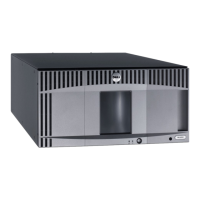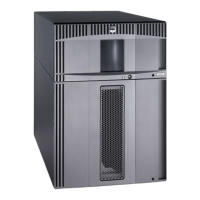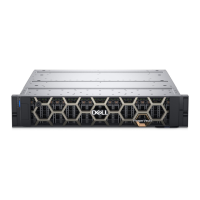Installing, Removing, and Replacing
file:///T|/htdocs/stor-sys/ML6000/en/html/ch08.htm[9/17/2012 1:50:35 PM]
Note: Pay attention to where the operator panel is positioned in the rack for optimum usability.
2 For each FC I/O blade installed in a 9U Library Expansion Module, connect the 9U Library Expansion Module containing
the FC I/O blade(s) to a port in the Ethernet hub on the LCB:
Note: Without these Ethernet cables connected, the FC I/O blades will not work.
a If the FC I/O blade is installed in the bottom bay of the 9U Library Expansion Module, connect one end of an
Ethernet cable to the Ethernet port labeled LOWER in the lower right corner of the 9U Library Expansion Module.
Connect the other end of the cable to a port in the Ethernet hub on the LCB.
b If the FC I/O blade is installed in the upper bay of the 9U Library Expansion Module, connect one end of an
ethernet cable to the Ethernet port labeled UPPER in the lower right corner of the 9U Library Expansion Module.
Connect the other end of the cable to a port in the ethernet hub on the LCB.
c Follow the instructions in Cable Management Guidelines for best practices in routing the Ethernet cables.
3 Remove and discard the necessary number of the black rubber protective covers from the ports on the FC I/O blades.
4 Carefully unwrap the FC cables and remove the two white plastic protective caps from each end of the cable.
Caution: FC cables will be damaged if they are bent at more than a four-inch arc.
5 Connect the FC cable to one of the following initiator ports on the FC I/O blade: 3, 4, 5, or 6. When you choose the
port, take into account the location of any other tape drives that you plan to connect to the same FC I/O blade. See
Cable Management Guidelines for best-practice guidelines for cabling a library.
6 Insert the other end of the FC cable into the FC port on the FC tape drive.
7 Repeat the above steps for each FC drive you want to connect to the FC I/O blade. Do not connect any of these FC
cables to ports 1 or 2 on the FC I/O blade.
8 Connect the host(s) to ports 1 and/or 2 on the FC I/O blade.
9 Install the module terminators.
Caution: The module terminator is not the same as a SCSI terminator. Using a SCSI terminator instead of a
module terminator will damage the library.
a Using the module terminators, terminate the top and bottom modules in the library stack. Install one module
terminator in the top terminator connector on the topmost module and one in the bottom terminator connector on
the bottommost module.
If your library configuration consists of a single module, place module terminators in the module's top and bottom
module terminator connectors.
b If you need to add 9U Library Expansion Modules to the 5U Library Control Module, remove the module terminator
from the 5U Library Control Module terminator connection that is closest to the 9U Library Expansion Module.
c Replace the module terminator in the 9U Library Expansion Module terminator connection furthest from the
5U Library Control Module.
10 Connect the module-to-module cable from the 5U Library Control Module to the 9U Library Expansion Module.
11 Connect an Ethernet cable to the Gigabit (GB) Ethernet port on the Library Control Blade (LCB) for remote access to
the library via the Web client.
12 Connect a power cord to the outlet on the power supply on the rear of the library.
There should always be a power cord connected to the power supply on the 5U Library Control Module. If redundant
power supplies are used, connect a power cord to each of the additional power supply outlets.
13 Power on the library.
a Turn on the rear power switch of each of the power supplies.
b Turn on the front power button.
c Power up the host system.
14 Verify communication with all devices on the bus.
15 Configure the library using the commands on the operator panel. See configuration information in Configuring Your
Library.

